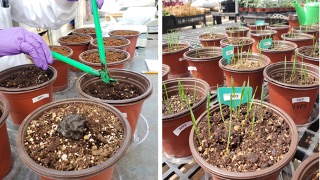Novel Method to Recover Nitrogen for Agriculture Fertilizer Developed by ERC
Outcome/Accomplishment
The NSF-funded Engineering Research Center (ERC) for Advancing Sustainable and Distributed Fertilizer Production (CASFER), headquartered at Texas Tech University, has developed a low-voltage electrochemical method to extract nitrogen from sewage sludge. The process has a 60% nitrogen recovery rate and uses 90% less energy compared with other electrochemical methods.
Impact/Benefits
By 2050, the global population is projected to surpass 10.5 billion, resulting in a 70% surge in food demand. Meanwhile, available land for agriculture will only increase by an additional 10%. The electrolysis of waste activated sludge has the potential to revolutionize the production of nitrogen-based fertilizers for food production.
Explanation/Background
The dominant form of fertilizer that is currently used in agriculture is synthetic nitrogen, which is primarily manufactured through an intensive carbon-emitting process. Additionally, only 20% of the nitrogen-based fertilizers that are produced directly contribute to food production. The remaining 80% are lost to the environment, leading to significant environmental, health, and socioeconomic impacts.
The NSF-funded team’s unique low-voltage electrochemical method breaks down sewage sludge at room temperature and allows for the release of nitrogen and phosphorus into the liquid phase. The structurally altered solid that is left behind captures up to 60% of the nitrogen contained in the sludge and reduces disposal costs by at least 25% when compared with conventional treatments.
Location
Lubbock, Texaswebsite
Start Year
Energy and Sustainability
Energy, Sustainability, and Infrastructure
Lead Institution
Core Partners
Fact Sheet
Outcome/Accomplishment
The NSF-funded Engineering Research Center (ERC) for Advancing Sustainable and Distributed Fertilizer Production (CASFER), headquartered at Texas Tech University, has developed a low-voltage electrochemical method to extract nitrogen from sewage sludge. The process has a 60% nitrogen recovery rate and uses 90% less energy compared with other electrochemical methods.
Location
Lubbock, Texaswebsite
Start Year
Energy and Sustainability
Energy, Sustainability, and Infrastructure
Lead Institution
Core Partners
Fact Sheet
Impact/benefits
By 2050, the global population is projected to surpass 10.5 billion, resulting in a 70% surge in food demand. Meanwhile, available land for agriculture will only increase by an additional 10%. The electrolysis of waste activated sludge has the potential to revolutionize the production of nitrogen-based fertilizers for food production.
Explanation/Background
The dominant form of fertilizer that is currently used in agriculture is synthetic nitrogen, which is primarily manufactured through an intensive carbon-emitting process. Additionally, only 20% of the nitrogen-based fertilizers that are produced directly contribute to food production. The remaining 80% are lost to the environment, leading to significant environmental, health, and socioeconomic impacts.
The NSF-funded team’s unique low-voltage electrochemical method breaks down sewage sludge at room temperature and allows for the release of nitrogen and phosphorus into the liquid phase. The structurally altered solid that is left behind captures up to 60% of the nitrogen contained in the sludge and reduces disposal costs by at least 25% when compared with conventional treatments.

